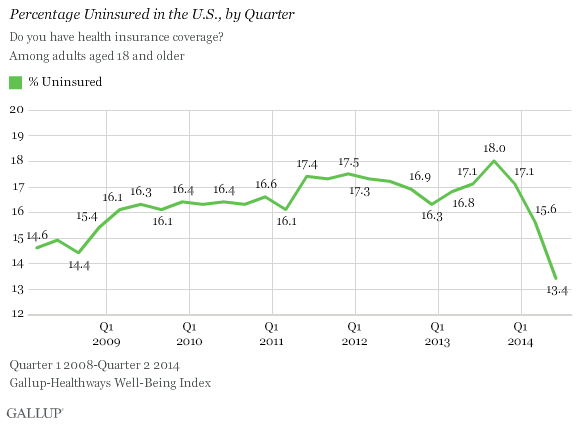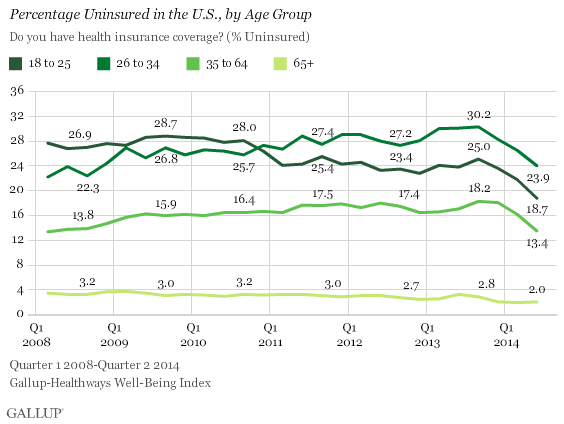WASHINGTON, D.C. -- The uninsured rate in the U.S. fell 2.2 percentage points to 13.4% in the second quarter of 2014. This is the lowest quarterly average recorded since Gallup and Healthways began tracking the percentage of uninsured Americans in 2008. The previous low point was 14.4% in the third quarter of 2008.

The uninsured rate has decreased sharply since the Affordable Care Act's requirement for most Americans to have health insurance went into effect at the beginning of 2014. In fact, the uninsured rate has dropped by 3.7 points since the fourth quarter of 2013, when it averaged 17.1%.
The decline in the uninsured rate last quarter took place at the start of the quarter. The drop reflected a surge of health plan enrollees in early April, prior to the April 15 extended enrollment deadline for people who had previously experienced technical difficulties with the federal healthcare exchange website. In April and May, the uninsured rate hovered at 13.4%, and it remained at that level in June -- clearly indicating that the decline seen since late 2013 has leveled off.
The second-quarter results are based on more than 45,000 interviews with U.S. adults from April 1 to June 30, 2014, as part of the Gallup-Healthways Well-Being Index.
Uninsured Rate Continues to Drop Across Age Groups
Gallup's quarterly trends show that the uninsured rate dropped by about three points from the fourth quarter of 2013 among each major age group under 65. The uninsured rate in the second quarter averaged 18.7% among 18- to 25-year-olds, 23.9% among 26- to 34-year-olds, and 13.4% among 35- to 64-year-olds.
Given the availability of Medicare and Medicaid benefits, very few seniors report being without health insurance, although the uninsured rate among those 65 and older is now 2.0%, down from 2.8% in the third quarter of 2013.

More 18- to 64-Year-Olds Have Self-Funded Insurance Now Than in 2013
While 18- to 64-year-olds are most likely to have health insurance through a current or former employer (43.5%), more reported having self-funded insurance coverage in the second quarter than did before the healthcare exchanges opened in October 2013. For Americans younger than 65, 20.7% say they have a health insurance plan they or a family member pays for, compared with 16.7% in August-September 2013.
There has also been a slight increase in the percentage who have Medicaid insurance, perhaps because a provision of the 2010 healthcare law expanded the qualifying income levels for Medicaid. Thus, the reduction in the percentage of uninsured Americans has been accompanied by increases in the percentages who now have Medicaid or self-funded insurance, through a government exchange or on their own.

Gallup and Healthways began asking about insurance types using the current question wording in August 2013. Respondents are asked, "Is your primary health insurance coverage through a current or former employer, a union, Medicare, Medicaid, military or veteran's coverage, or a plan fully paid for by you or a family member?" Respondents who say they have a secondary form of health insurance are also asked, "Thinking about this secondary health insurance coverage, is it through a current or former employer, a union, Medicare, Medicaid, military or veteran's coverage, or a plan fully paid for by you or a family member?" The results reported here are a combined estimate of primary and secondary insurance types.
Implications
The uninsured rate fell 2.2 points in the second quarter, evidently due to a surge in the percentage of Americans who completed their enrollment in healthcare plans just before the mid-April deadline. The uninsured rate has since been flat at about 13.4%, suggesting that there won't be further reductions in the rate until after the open enrollment period for 2015 begins on Nov. 15. And although Medicaid has added to the increase in health insurance coverage as more states have adopted expansion provisions over the past few months, it remains unclear how many Americans were previously insured and moved to Medicaid to reduce costs.
Throughout the enrollment period for 2014, the Obama administration increased outreach efforts to young Americans, including 26- to 34-year-olds, and Hispanics. It is likely these groups will be targeted again in the months leading up to the enrollment period for 2015 as they are the subgroups with the highest uninsured rates.
Survey Methods
Results are based on telephone interviews conducted as part of the Gallup-Healthways Well-Being Index survey April 1-June 30, 2014, with a random sample of 45,125 adults, aged 18 and older, living in all 50 U.S. states and the District of Columbia.
For results based on the total sample of national adults, the margin of sampling error is ±1 percentage point at the 95% confidence level.
Interviews are conducted with respondents on landline telephones and cellular phones, with interviews conducted in Spanish for respondents who are primarily Spanish-speaking. Each sample of national adults includes a minimum quota of 50% cellphone respondents and 50% landline respondents, with additional minimum quotas by time zone within region. Landline and cellular telephone numbers are selected using random-digit-dial methods. Landline respondents are chosen at random within each household on the basis of which member had the most recent birthday.
Samples are weighted to correct for unequal selection probability, nonresponse, and double coverage of landline and cell users in the two sampling frames. They are also weighted to match the national demographics of gender, age, race, Hispanic ethnicity, education, region, population density, and phone status (cellphone only/landline only/both, and cellphone mostly). Demographic weighting targets are based on the most recent Current Population Survey figures for the aged 18 and older U.S. population. Phone status targets are based on the most recent National Health Interview Survey. Population density targets are based on the most recent U.S. census. All reported margins of sampling error include the computed design effects for weighting.
In addition to sampling error, question wording and practical difficulties in conducting surveys can introduce error or bias into the findings of public opinion polls.
For more details on Gallup's polling methodology, visit www.gallup.com.
